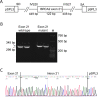Novel de novo BRCA2 mutation in a patient with a family history of breast cancer
- PMID: 18597679
- PMCID: PMC2478678
- DOI: 10.1186/1471-2350-9-58
Novel de novo BRCA2 mutation in a patient with a family history of breast cancer
Abstract
Background: BRCA2 germ-line mutations predispose to breast and ovarian cancer. Mutations are widespread and unclassified splice variants are frequently encountered. We describe the parental origin and functional characterization of a novel de novo BRCA2 splice site mutation found in a patient exhibiting a ductal carcinoma at the age of 40.
Methods: Variations were identified by denaturing high performance liquid chromatography (dHPLC) and sequencing of the BRCA1 and BRCA2 genes. The effect of the mutation on splicing was examined by exon trapping in COS-7 cells and by RT-PCR on RNA isolated from whole blood. The paternity was determined by single nucleotide polymorphism (SNP) microarray analysis. Parental origin of the de novo mutation was determined by establishing mutation-SNP haplotypes by variant specific PCR, while de novo and mosaic status was investigated by sequencing of DNA from leucocytes and carcinoma tissue.
Results: A novel BRCA2 variant in the splice donor site of exon 21 (nucleotide 8982+1 G-->A/c.8754+1 G-->A) was identified. Exon trapping showed that the mutation activates a cryptic splice site 46 base pairs 3' of exon 21, resulting in the inclusion of a premature stop codon and synthesis of a truncated BRCA2 protein. The aberrant splicing was verified by RT-PCR analysis on RNA isolated from whole blood of the affected patient. The mutation was not found in any of the patient's parents or in the mother's carcinoma, showing it is a de novo mutation. Variant specific PCR indicates that the mutation arose in the male germ-line.
Conclusion: We conclude that the novel BRCA2 splice variant is a de novo mutation introduced in the male spermatozoa that can be classified as a disease causing mutation.
Figures




References
-
- Smith P, McGuffog L, Easton DF, Mann GJ, Pupo GM, Newman B, Chenevix-Trench G, Szabo C, Southey M, Renard H, Odefrey F, Lynch H, Stoppa-Lyonnet D, Couch F, Hopper JL, Giles GG, McCredie MR, Buys S, Andrulis I, Senie R, Goldgar DE, Oldenburg R, Kroeze-Jansema K, Kraan J, Meijers-Heijboer H, Klijn JG, van Asperen C, van Leeuwen I, Vasen HF, Cornelisse CJ, Devilee P, Baskcomb L, Seal S, Barfoot R, Mangion J, Hall A, Edkins S, Rapley E, Wooster R, Chang-Claude J, Eccles D, Evans DG, Futreal PA, Nathanson KL, Weber BL, Rahman N, Stratton MR. A genome wide linkage search for breast cancer susceptibility genes. Genes Chromosomes Cancer. 2006;45:646–655. doi: 10.1002/gcc.20330. - DOI - PMC - PubMed
Publication types
MeSH terms
LinkOut - more resources
Full Text Sources
Medical
Miscellaneous

